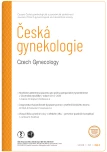Monitoring the relationship between overactive bladder and mobility disorders in women with multiple sclerosis
Authors:
C. Grus
Authors‘ workplace:
Katedra fyzioterapie, FZO PU v Prešove, Slovenská republika
Published in:
Ceska Gynekol 2023; 88(5): 353-358
Category:
Original Article
doi:
https://doi.org/10.48095/cccg2023353
Overview
Background: Currently, there is a lack of studies monitoring the relationship between lower urinary tract symptoms and mobility disorders in women with multiple sclerosis. The aim of this study was to monitor the relationship between overactive bladder and mobility impairments in women with multiple sclerosis. Methods: A number of 106 female patients with multiple sclerosis (MS) with relapsing-remitting (RR) form, disability stage: EDSS ≤ 6.5, from the specialized outpatient clinic of the Department of Neurology, Faculty of Medicine, University of Medical Sciences in Košice. Urinary leakage symptoms were assessed by the modified International Consultation on Incontinence Questionnaire (ICIQ UI-SF), and overactive bladder symptoms were assessed by the Short Overactive Bladder Symptoms Questionnaire (OAB-q). The Multiple Sclerosis Impact Scale (MSIS-29) and the Rivermead Mobility Index (RMI) were used. Conclusion: In MS patients, we found the following correlations: a significant positive mean correlation between the severity of OAB and UI symptoms and physical attributes. We found a significant positive moderate correlation between severity of OAB and UI symptoms and psychological attributes. We found a negative significant moderate correlation between OAB and UI symptom severity and mobility. It was confirmed that the more severe the symptoms of UI and OAB, the greater the difficulty of mobility in performing physical activities, and thus the negative impact of SM disease on patients' psychological health increases.
Keywords:
Multiple sclerosis – mobility – overactive bladder
Sources
1. Szislasiova J. Sekundárne progresívna forma sclerosis multiplex: diagnostika a možnosti liečby. Neurol praxi 2020; 21 (3): 37–40. doi: 10.36290/neu.2020.023.
2. Krhut J, Martan A, Zachoval R et al. Diagnostika a léčba hyperaktivního močového měchýře v České republice před pěti lety a dnes. Ceska Gynekol 2012; 77 (3): 205–210.
3. Martan A, Mašata J, Švabík K. Management recidivující stresové inkontinence moči po selhání efektu anti-inkontinentních operací. Ceska Gynekol 2017; 82 (1): 59–64.
4. Hagovská M, Švihra J, Buková A et al. Effect of an exercise programme for reducing abdominal fat on overactive bladder symptoms in young overweight women. Int Urogynecol J 2020; 31 (5): 895–902. doi: 10.1007/s00192-019-04157-8.
5. Hagovska M, Švihra J, Buková A et al. The impact of different intensities of exercise on body weight reduction and overactive bladder symptoms – randomised trial. Eur J Obstet Gynecol Reprod Biol 2019; 242: 144–149. doi: 10.1016/ j.ejogrb.2019.09.027.
6. Bø K, Hilde G, Tennfjord MK et al. Pelvic floor muscle function, pelvic floor dysfunction and diastasis recti abdominis: prospective cohort study. Neurourol Urodyn 2017; 36 (3): 716–721. doi: 10.1002/nau.23005.
7. Hagovská M, Švihra J. Evaluation of duloxetine and innovative pelvic floor muscle training in women with stress urinary incontinence (DULOXING): study protocol clinical trial (SPIRIT Compliant). Medicine (Baltimore) 2020; 99 (6): e18834. doi: 10.1097/MD.0000000000018 834.
8. Hagovská M, Švihra J, Breza J Jr et al. A randomized, intervention parallel multicentre study to evaluate duloxetine and innovative pelvic floor muscle training in women with uncomplicated stress urinary incontinence – the DULOXING study. Int Urogynecol J 2021; 32 (1): 193–201. doi: 10.1007/s00192-020-04516-w.
9. Dufek M. Roztroušená skleróza – EDSS (expended disability status scale), tzv. Kurtzkeho škála. Neurol praxi 2011; 12: 6–9.
10. Kurtzke JF. Rating neurologic impairment in multiple sclerosis: an expanded disability status scale (EDSS). Neurology 1983; 33 (11): 1444–1452. doi: 10.1212/wnl.33.11.1444.
11. Avery K, Donovan J, Peters TJ et al. ICIQ: a brief and robust measure for evaluating the symptoms and impact of urinary incontinence. Neurol Urodyn 2004; 23 (4): 322–330. doi: 10.1002/nau.20041.
12. Coyne KS, Matza LS, Thompson CL. The responsiveness of the Overactive Bladder Questionaire (OAB-q). Qual Life Res 2005; 14 (3): 849–855. doi: 10.1007/s11136-004-0706-1.
13. Forlander DA, Bohannon RW. Rivermead mobility index: a brief review of research to date. Clin Rehabil 1999; 13 (2): 97–100. doi: 10.1191/026921599675502264.
14. Hobart J, Lamping D, Fitzpatrick R et al. The multiple sclerosis impact scale (MSIS-29): a new patient-based outcome measure. Brain 2001; 124 (Pt 5): 962–973. doi: 10.1093/brain/124.5.962.
15. Nazari F, Shaygannejad V, Sichani MM et al. The prevalence of lower urinary tract symptoms based on individual and clinical parameters in patients with multiple sclerosis. BMC Neurol 2020; 20 (1): 24. doi: 10.1186/s12883-019-1582-1.
16. Abakay H, Doğan H, Yetkin MF et al. The effects of incontinence on functionality, disability, and quality of life in male and female patients with multiple sclerosis. Mult Scler Relat Disord 2022; 66: 104010. doi: 10.1016/ j.msard.2022.104010.
17. Hentzen C, Villaumé A, Turmel N et al. Are falls in people with multiple sclerosis related to the severity of urinary disorders? Ann Phys Rehabil Med 2021; 64 (4): 101452. doi: 10.1016/ j.rehab.2020.10.006.
18. Gaspard L, Tombal B, Castille Y et al. Pelvic floor muscles training, electrical stimulation, bladder training and lifestyle interventions to manage lower urinary tract dysfunction in multiple sclerosis: a systematic review. In Prog Urol 2014; 24: 222–228. doi: 10.1016/ j.purol.2013.11.004.
19. Martinková P, Freeman J, Drabinová A et al. Physiotherapeutic interventions in multiple sclerosis across Europe: regions and other factors that matter. Mult Scler Relat Disord 2018; 22: 59–67. doi: 10.1016/j.msard.2018.03.005.
20. Cattaneo D, Rasova K, Gervasoni E et al. Falls prevention and balance rehabilitation in multiple sclerosis: a bi-centre randomised controlled trial. Disabil Rehabil 2018; 40 (5): 522–526. doi: 10.1080/09638288.2016.1258089.
21. Bučková B, Kopal J, Řasová K et al. Open access: the effect of neurorehabilitation on multiple sclerosis-unlocking the resting-state fMRI data. Front Neurosci 2021; 15: 662784. doi: 10.3389/fnins.2021.662784.
Labels
Paediatric gynaecology Gynaecology and obstetrics Reproduction medicineArticle was published in
Czech Gynaecology

2023 Issue 5
Most read in this issue
- Early treatment of vulvar synechiae in childhood – prevention of late complications
- Relugolix combination therapy and symptoms of uterine myomatosis – selected case reports of indication spectrum and treatment outcomes
- Implementation of the ERAS protocol in gynecology and oncogynecology – evaluation of a pilot study
- Nascent myoma as a cause of urinary retention
